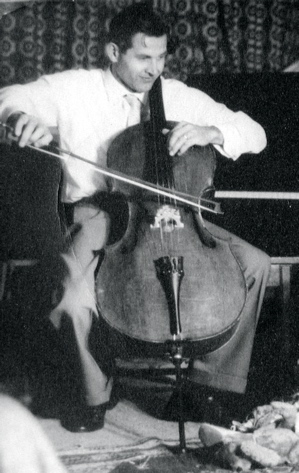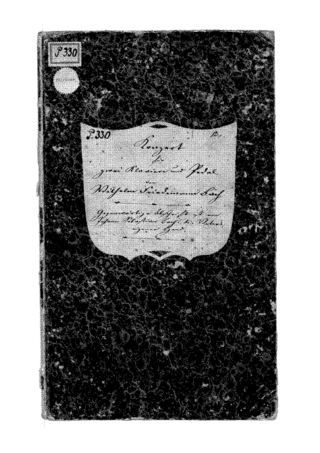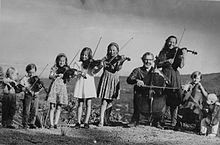Karl Richter was a German conductor, choirmaster, organist, and harpsichordist.

The sonatas and partitas for solo violin are a set of six works composed by Johann Sebastian Bach. They are sometimes referred to in English as the sonatas and partias for solo violin in accordance with Bach's headings in the autograph manuscript: "Partia" was commonly used in German-speaking regions during Bach's time, whereas the Italian "partita" was introduced to this set in the 1879 Bach Gesellschaft edition, having become standard by that time. The set consists of three sonatas da chiesa in four movements and three partitas in dance-form movements. The 2nd Partita is widely known for its Chaconne, considered one of the most masterly and expressive works ever written for solo violin.
D minor is a minor scale based on D, consisting of the pitches D, E, F, G, A, B♭, and C. Its key signature has one flat. Its relative major is F major and its parallel major is D major.

The Partita in D minor for solo violin by Johann Sebastian Bach was written between 1717 and 1720. It is a part of his compositional cycle called Sonatas and Partitas for Solo Violin.

Michaela Paetsch Neftel was an American violinist who was born in Colorado Springs. She was known for being the first American female to have recorded all 24 Paganini Caprices for solo violin. She was first prize winner in the 1984 G. B. Dealey Awards and a top prize winner in the 1985 Queen Elisabeth Competition and a special prize winner at the International Tchaikovsky Competition held in 1986.

The Trio Ceresio is an internationally renowned Swiss classical music piano trio founded in Lugano, Switzerland, which has performed worldwide much of the piano trio repertoire.
Laszlo Varga was a Hungarian-born American cellist who had a worldwide status as a soloist, recording artist, and authoritative cello teacher.

The keyboard concertos, BWV 1052–1065, are concertos for harpsichord, strings and continuo by Johann Sebastian Bach. There are seven complete concertos for a single harpsichord, three concertos for two harpsichords, two concertos for three harpsichords, and one concerto for four harpsichords. Two other concertos include solo harpsichord parts: the concerto BWV 1044, which has solo parts for harpsichord, violin and flute, and Brandenburg Concerto No. 5 in D major, with the same scoring. In addition, there is a nine-bar concerto fragment for harpsichord which adds an oboe to the strings and continuo.

Johann Ernst of Saxe-Weimar was a German prince, son by his second marriage of Johann Ernst III, Duke of Saxe-Weimar. Despite his early death he is remembered as a collector and commissioner of music and as a composer, some of whose concertos were arranged for harpsichord or organ by Johann Sebastian Bach, who was court organist in Weimar at the time.

Martin Rummel is an Austrian cellist.

The Chromatic Fantasia and Fugue in D minor, BWV 903, is a work for harpsichord by Johann Sebastian Bach. Bach probably composed it during his time in Köthen from 1717 to 1723. The piece was already regarded as a unique masterpiece during his lifetime. It is now often played on piano.
The Concerto, BWV 525a, is a trio sonata in C major for violin, cello and basso continuo, based on material otherwise found in Johann Sebastian Bach's first Organ Sonata, BWV 525, and Flute Sonata in A major, BWV 1032. The oldest extant manuscript containing the BWV 525a arrangement, D-B Mus.ms. Bach St 345, is dated to the middle of the 18th century. Although this version of Bach's sonata movements may have originated during his lifetime in the circle around him, it seems unlikely that the composer supervised, or even ordered, the manufacture of the string trio adaptation, thus the arrangement has been listed in BWV Anh. II, that is the Anhang (Anh.) of doubtful works, in the 1998 edition of the Bach-Werke-Verzeichnis (BWV). Breitkopf & Härtel published BWV 525a in 1965. Digital facsimiles of 18th- and 19th-century manuscript copies of the arrangement, in which the sonata is titled "Concerto", became available in the 21st century.
The Triple Concerto, BWV 1044, is a concerto in A minor for traverso, violin, harpsichord, and string orchestra by Johann Sebastian Bach. He based the composition on his Prelude and Fugue BWV 894 for harpsichord and on the middle movement of his Organ Sonata BWV 527, or on earlier lost models for these compositions.

Günther Johannes Paetsch, a native of Germany, was a cellist and co-founder of the Paetsch Family Chamber Music Ensemble in Colorado Springs, Colorado, United States. He is the husband of violinist Priscilla Paetsch and the father of their seven children.
The concerto transcriptions of Johann Sebastian Bach date from his second period at the court in Weimar (1708–1717). Bach transcribed for organ and harpsichord a number of Italian and Italianate concertos, mainly by Antonio Vivaldi, but with others by Alessandro Marcello, Benedetto Marcello, Georg Philipp Telemann and the musically talented Prince Johann Ernst of Saxe-Weimar. It is thought that most of the transcriptions were probably made in 1713–1714. Their publication by C.F. Peters in the 1850s and by Breitkopf & Härtel in the 1890s played a decisive role in the Vivaldi revival of the twentieth century.

The organ concertos of Johann Sebastian Bach are solo works for organ, transcribed and reworked from instrumental concertos originally composed by Antonio Vivaldi and the musically talented Prince Johann Ernst of Saxe-Weimar. While there is no doubt about the authenticity of BWV 592–596, the sixth concerto BWV 597 is now probably considered to be spurious. Composed during Bach's second period at the court in Weimar (1708–1717), the concertos can be dated more precisely to 1713–1714.
Lost versions of compositions by Johann Sebastian Bach can be reconstructed on the basis of extant versions of similar music. Reasons for such reconstructions include extension of the repertoire and testing hypotheses about the genesis history of known pieces. For instance, in the late 19th century it was discovered that Bach likely transcribed his Concerto for two harpsichords in C minor, BWV 1060, from a lost earlier version for violin and oboe. Reconstructions of BWV 1060 to its presumed original version, published from the 1920s, extended the Bach repertoire for oboists.












